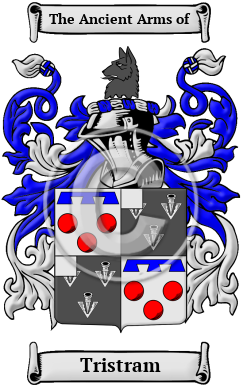| ![Show Contents]() Tristram History, Family Crest & Coats of Arms Tristram History, Family Crest & Coats of Arms
Early Origins of the Tristram familyThe surname Tristram was first found in Devon where "it appears as a Christian name in England from the end of the 12th century, usually in the form Tristram." 1 The name is derived from the Celtic Drystan, from drestm drust meaning 'tumult, din.' 1 Another source claims the name was from the Cornish Trestean, Tresteen, probably meaning the Stained or Coloured House [Cornish and Welsh tre, a homestead, farm, etc. + the Cornish cogn. of Welsh ystaen, stained, coloured]. "It is tempting to see the Cornish stean = Welsh ystaen, tin, in this name." 2 Found initially as a forename, early rolls show Tristam Cementarius in the Curia Regis Rolls of 1204. Tristram le Cheverer was found in London in 1278 and Tristam Merewyne was listed in the Subsidy Rolls for Sussex in 1296. 1 As a surname, we found Henry Tristram in the Pipe Rolls for Essex in 1207; Leonard Tristram in the Subsidy Rolls for Sussex in 1296; and Richard Tristram in the Subsidy Rolls for Kent in 1334. 1 Tristan (Tristram or Tristain) is the hero of the legend of Tristan and Iseult. In the legend, he is tasked with escorting the Irish princess Iseult to wed Tristan's uncle, King Mark of Cornwall, but they accidentally drink a love potion during the journey and fall in love. Tristan is banished and later died. According to the legend, his is the nephew of King Mark of Cornwall. Today the The Tristan Stone, or The Longstone (Cornish: Menhir, meaning long stone), stands beside the road leading to Fowey in Cornwall. Richard Wagner composed the opera Tristan and Isolde based on the legend in the mid 19th century. Since then, there have been numerous films based on the character and his plight. Early History of the Tristram familyThis web page shows only a small excerpt of our Tristram research. Another 147 words (10 lines of text) covering the years 1080, 1163, 1510, 1577, 1600, 1622, 1629 and 1784 are included under the topic Early Tristram History in all our PDF Extended History products and printed products wherever possible. Tristram Spelling VariationsCornish surnames are characterized by a multitude of spelling variations. The frequent changes in surnames are due to the fact that the Old and Middle English languages lacked definite spelling rules. The official court languages, which were Latin and French, were also influential on the spelling of a surname. Since the spelling of surnames was rarely consistent in medieval times, and scribes and church officials recorded names as they sounded rather than adhering to any specific spelling rules, it was common to find the same individual referred to with different spellings of their surname in the ancient chronicles. Moreover, a large number of foreign names were brought into England, which accelerated and accentuated the alterations to the spelling of various surnames. Lastly, spelling variations often resulted from the linguistic differences between the people of Cornwall and the rest of England. The Cornish spoke a unique Brythonic Celtic language which was first recorded in written documents during the 10th century. However, they became increasingly Anglicized, and Cornish became extinct as a spoken language in 1777, although it has been revived by Cornish patriots in the modern era. The name has been spelled Tristram, Trestram, Tristam and others. Early Notables of the Tristram family- the Tristram family of Devon
| Tristram migration to the United States | + |
A look at the immigration and passenger lists has shown a number of people bearing the name Tristram:
Tristram Settlers in United States in the 17th Century- Ralph Tristram, who arrived in New England in 1652 3
Tristram Settlers in United States in the 19th Century- William H Tristram, who landed in New York, NY in 1838 3
- William Tristram, who sailed to New York in 1838
| Contemporary Notables of the name Tristram (post 1700) | + |
- David Tristram (b. 1957), English comic playwright who has published twenty three plays, videos/two films and a comedy novel
- The Reverend Henry Baker Tristram FRS (1822-1906), English clergyman, Biblical scholar, traveller and ornithologist
- Ernest William Tristram (1882-1952), British art historian, artist and conservator, Professor of Design at the Royal College of Art (1926-1948)
- Jenna Tristram (b. 1986), Australian footballer who has played for the Australia Nation Team since 2007
- John William Tristram (1870-1938), Australian watercolour artist
- Ernest Tristram Crutchley CB CMG CBE (1878-1940), British civil servant, the first British High Commissioner to Australia
- Mr. Lawrence Tristram Smith B.E.M., British recipient of the British Empire Medal on 8th June 2018, for services to the community in Lewisham and Bromley, London
- Hugo Tristram Engelhardt (b. 1941), American philosopher specializing in the history and philosophy of medicine
- Tristram Roger Dymoke Powell (1940-2024), English television and film director, producer and screenwriter born in Oxford
- Reaney, P.H and R.M. Wilson, A Dictionary of English Surnames. London: Routledge, 1991. Print. (ISBN 0-415-05737-X)
- Harrison, Henry, Surnames of the United Kingdom: A Concise Etymological Dictionary Baltimore: Geneological Publishing Company, 2013. Print
- Filby, P. William, Meyer, Mary K., Passenger and immigration lists index : a guide to published arrival records of about 500,000 passengers who came to the United States and Canada in the seventeenth, eighteenth, and nineteenth centuries. 1982-1985 Cumulated Supplements in Four Volumes Detroit, Mich. : Gale Research Co., 1985, Print (ISBN 0-8103-1795-8)
 |

